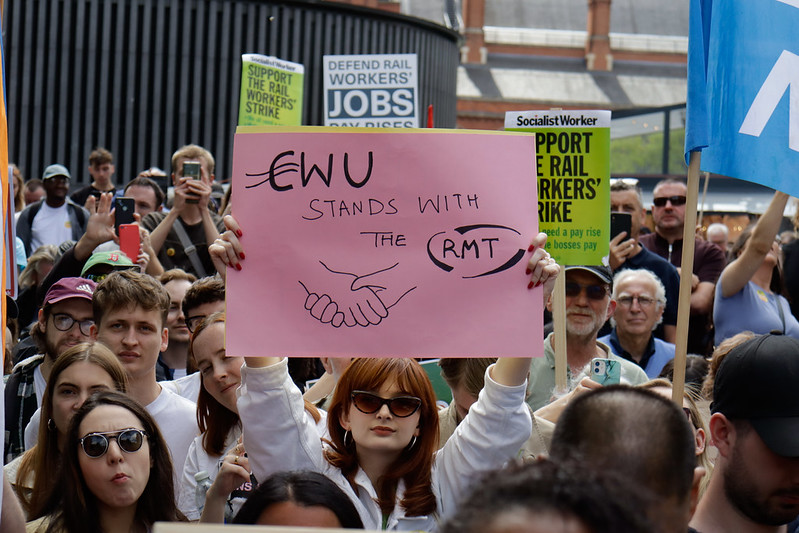Since last summer, Britain has seen a noticeable increase in industrial disputes, as indicated by the much reported-on increase in day’s lost statistics since May 2022. What has been noticeable is that there has been a significant increase in both local and national dispute; as a result, we have seen the media profile of trade unions dramatically increase. However, in spite of the frequency of industrial action and increased media attention on organised labour, much of the coverage of this industrial unrest still presents the strikes as discrete, almost novel, events. There have been references to ‘Hot Strike Summer’, a ‘Winter of Discontent’, and a ‘Summer of Discontent’ but such analysis misses the point, rather than being a distinct political event, this more turbulent industrial climate is now the new normal.
The economic situation remains suboptimal. For most workers, the situation will not dramatically improve any time soon. This means that, in both private and public sectors, there will remain good reasons for workers to engage in industrial action. Widespread economic pressures make national scale disputes more likely as a greater number of workers will be affected by the same pressures and, with industrial action being a newsitem again, will exercise what limited power they have.
At a more national level, many of the national disputes have so far only been temporarily resolved and are in a tenuous holding pattern. For instance, although the RMT have settled with Network Rail, the fact that Network Rail have already started implementing its modernisation agenda means that there will be future disputes over this. Equally, the proposed CWU and Royal Mail deal (currently being voted on by CWU members) leaves plenty of ambiguity over what will happen in two years’ time once it expires, and it is an open question about what will happen with NHS pay next year. Indeed, the long running UCU disputes with UCEA and USS highlight how disputes can run and run when the underlying causes (be they modernisation, a declining industry, or the unnecessary imposition of market forces) are not addressed. Industrial relations are just that, a set of relations that vary depending on the immediate and historical conditions; they are not a fixed immutable thing that is frozen with the settling of industrial action.
On a practical level, some workers are becoming more used to striking and there has been a cultural shift. The moribund middle-class has discovered industrial action, as demonstrated by doctors and criminal barristers turning towards industrial action as a last recourse for their declining sectors. As well as this, industrial action can be a potent recruiting tool for trade unions – the challenge is maintaining retention post-action.
Interestingly, trade union membership fell in 2022 despite the number of days lost to strike action being the highest since 1989. This may be due to the first half of the year being fairly strike free, and the recruitment impact of industrial action will likely be more evident in the figures for 2023. Even if membership remains largely stagnant, new activists and leaders will have been unearthed as a result of the current action, meaning that future organising will be easier and more effective.
As well as this, on a mechanical level, trade unions have got better at balloting for strike action, both at a local (as shown by GMB’s successful re-ballot attempt at Amazon in Coventry in December) and a national level. A year ago it would have been largely unthinkable that trade unions could regularly breach the threshold of 50% turnout, and 40% yes vote for key industries, on a postal vote. But now we have seen successful industrial action ballots encompassing the entire higher education sector, all of Royal Mail, the NHS, the railways, and schools, with some of these passing 70% turnout. Much of this is due to economic circumstances pressuring workers into industrial action, but a lot of it is also because trade unions are getting better at balloting, whether that is using mass-texting software or becoming more adroit at mundane activities such as database scrubbing. Perhaps the greatest testament to organised labour’s new efficacy at overcoming the barriers put in place by anti trade union legislation is the government’s efforts to pass more of it with the Minimum Service Bill.
Politicians and the media need to engage with this new reality and start exploring how a government, whether current or prospective, navigates and administers this new industrial landscape. The current government looks clueless on this and has floundered in its attempts to either ignore the industrial unrest or legislate it away. Equally, while Labour has interesting proposals in its New Deal for Working People, this green paper was put together in 2021 (with much of it being carried over from the 2019 manifesto), and the situation is now different. While saying they would negotiate is a good start, it is not in and of itself a sufficient approach. But regardless of what Labour do, increased industrial action is here to stay.


